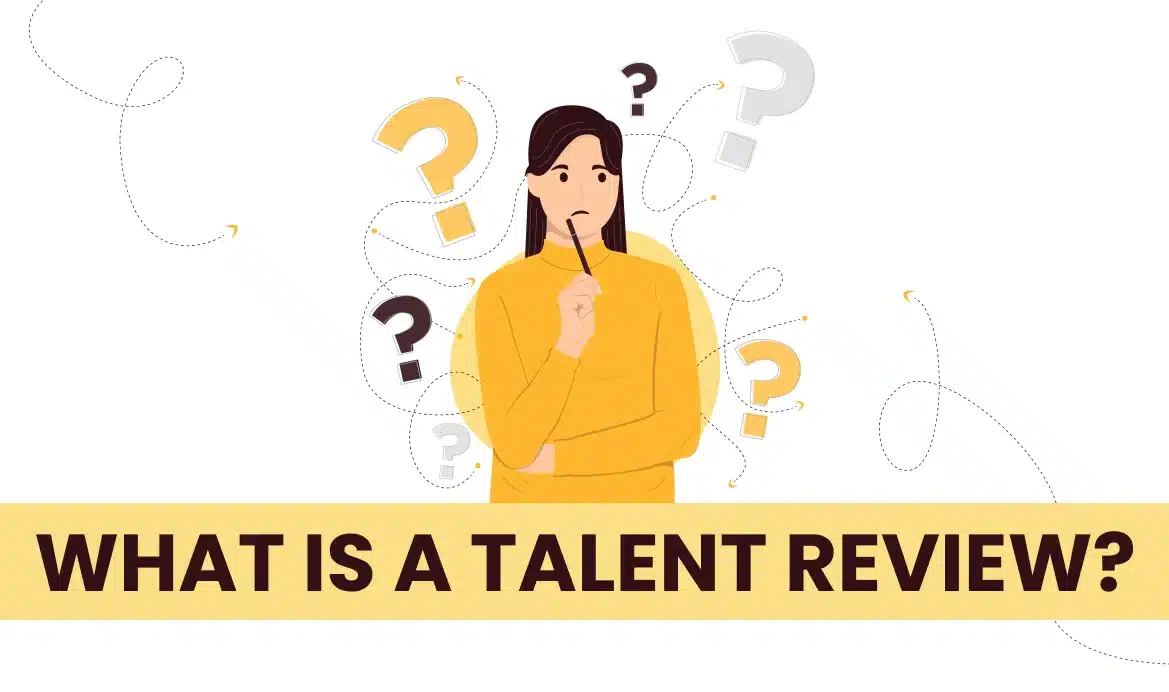Every company says its people are its greatest asset, but few have a clear system to identify who their real high-performers are. Without structure, potential goes unnoticed, future leaders remain hidden, and development efforts miss the mark.
According to Gartner, only 32% of HR leaders believe their organization effectively identifies and develops high-potential employees. Meanwhile, LinkedIn’s 2023 Workplace Learning Report shows that companies with strong talent development programs experience 57% lower turnover than those that don’t.
This gap between awareness and action is exactly what talent reviews are designed to close. They give leaders the visibility they need to understand who is excelling, who needs support, and who could step into leadership tomorrow.
In this blog, we’ll explore five proven methods to conduct effective talent reviews, helping you build a workforce that is not only high-performing but ready for the future.
What is a Talent Review?
A talent review is a structured process used by HR leaders and managers to assess employee performance, potential, and readiness for future roles. It helps organizations make informed decisions about promotions, development, and succession planning.
The process typically includes:
-
Evaluating employee performance and competencies
-
Identifying high-potential individuals
-
Planning personalized development paths
-
Aligning talent with business goals
When done correctly, talent reviews build a strong leadership pipeline and ensure that every employee has a clear path to growth.
5 Ways to Perform Talent Review for Your Employees
Effective review processes are essential for any organization aiming to identify, develop, and retain its most valuable employees. By systematically evaluating your workforce, you can recognize high-potential individuals, address critical skills gaps, and create a talent pipeline for future leadership roles. Here are five methods for performing reviews for talents that can help your organization optimize the talent pool:
1. 360-Degree Feedback Reviews
Why it works: 360-degree feedback gives a complete picture of an employee’s performance by collecting insights from multiple perspectives — managers, peers, subordinates, and even clients.
This method helps eliminate bias by balancing viewpoints. It uncovers strengths in teamwork, communication, and leadership that might not appear in traditional top-down reviews.
How to apply it effectively:
-
Use structured feedback forms focused on skills and behaviors.
-
Summarize themes rather than individual comments to maintain confidentiality.
-
Discuss results with employees in a constructive session focused on growth, not evaluation.
360 reviews encourage self-awareness and create a foundation for personalized development plans.
2. Succession Planning Reviews
Succession planning reviews identify employees with the potential to take on key roles in the future. They’re not just for executives, every department benefits from having a clear talent pipeline.
How to conduct it:
-
Evaluate employees on both performance and potential using a simple matrix (like the 9-box grid).
-
Assess leadership readiness and learning agility.
-
Assign development actions such as mentorship, rotational projects, or leadership training.
Succession planning ensures continuity when leaders move on and prevents last-minute talent shortages that disrupt business operations.
3. Calibration Meetings
Calibration meetings bring managers and HR leaders together to review performance data collectively. The goal is to create consistency across the organization so that one manager’s “high performer” means the same as another’s.
Key steps for effective calibration:
-
Share employee performance summaries before the meeting.
-
Encourage open discussion and challenge biases in ratings.
-
Align ratings with business impact, not personal preferences.
Calibration promotes fairness and transparency, helping companies make equitable decisions on promotions and development opportunities.
4. Competency-Based Assessments
Competency assessments measure how well employees’ skills and behaviors align with organizational goals. Unlike subjective evaluations, this method uses measurable criteria tied to job success.
How to implement:
-
Identify core competencies for each role, such as analytical thinking, innovation, or leadership.
-
Use self-assessments and manager evaluations to compare perceptions.
-
Map results to identify both high-potential employees and skill gaps.
This data-driven approach gives HR and managers clarity on where to focus training and development investments.
5. Talent Mapping Reviews
Talent mapping provides a visual snapshot of your organization’s talent landscape. It helps identify top performers, critical skill gaps, and future leadership potential in one view.
How to perform it:
-
Gather performance and potential data from previous reviews.
-
Use visualization tools (like a 9-box grid or heat map) to classify employees by readiness and impact.
-
Use insights to make data-backed decisions about promotions, internal mobility, and training priorities.
Talent mapping turns raw performance data into strategic foresight, enabling smarter workforce planning.
Best Practices for Effective Talent Reviews
To get the most value from your talent reviews, consistency and transparency are essential. Here’s how to make them work in the long run:
1. Keep Data Accurate and Updated
Base every review on reliable data — recent performance metrics, engagement surveys, and feedback from multiple stakeholders. Outdated or incomplete data leads to poor decisions.
2. Make It a Continuous Process
Talent reviews should not be annual checkboxes. Quarterly or biannual reviews help organizations stay agile and respond to changing priorities.
3. Prioritize Development, Not Just Evaluation
A good review doesn’t end with labels like “high potential” or “needs improvement.” Turn insights into actionable development plans that help employees grow.
4. Maintain Transparency and Trust
Communicate the purpose, process, and outcomes of talent reviews clearly. When employees understand that the process is about growth, not judgment, they are more engaged and cooperative.
5. Align with Organizational Strategy
Talent reviews should directly support business goals. Whether your focus is innovation, expansion, or leadership continuity, identify and develop talent that can drive those priorities forward.
Conclusion
Talent reviews are not just HR exercises; they are strategic tools for building a resilient, future-ready organization. By using structured methods like 360-degree feedback, succession planning, calibration meetings, competency assessments, and talent mapping, you can uncover high-potential employees and create targeted growth plans that align with business needs.
The most effective reviews don’t just evaluate performance, they turn insights into action. When talent management becomes a continuous, transparent, and data-driven process, your organization gains the clarity and confidence to nurture its next generation of leaders.
Frequently Asked Questions
1. What is the main purpose of a talent review?
A talent review helps organizations evaluate employees’ performance, potential, and readiness for future roles. The goal is to identify high-potential individuals, close skill gaps, and build a strong leadership pipeline. It ensures that development and promotion decisions are based on data, not assumptions.
2. How often should companies conduct talent reviews?
Most organizations perform talent reviews once or twice a year, depending on their size and growth rate. However, the most effective companies treat it as a continuous process, integrating performance discussions and development tracking throughout the year.
3. What is the difference between a talent review and a performance review?
A performance review focuses on how well an employee met their current job objectives. A talent review goes further by evaluating long-term potential, leadership qualities, and career growth opportunities. In short, performance reviews assess the past, while talent reviews plan for the future.
4. Who should be involved in the talent review process?
Ideally, talent reviews should include managers, department heads, and HR professionals. Involving multiple stakeholders ensures a balanced assessment and reduces bias. Calibration meetings can also help align different perspectives and maintain consistency across the organization.
5. How does Supersourcing help companies with talent management?
Supersourcing helps organizations build and manage high-performing remote engineering teams with a focus on transparency, skill assessment, and long-term development. By combining data-driven evaluation with personalized support, Supersourcing enables businesses to identify and retain top talent more effectively.


